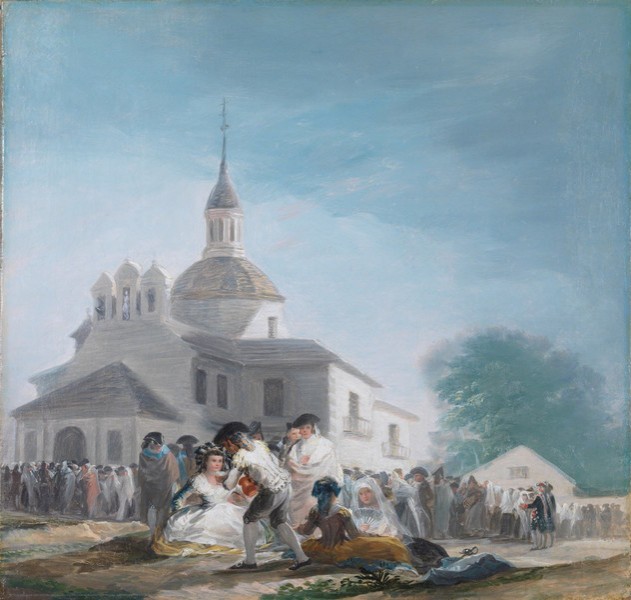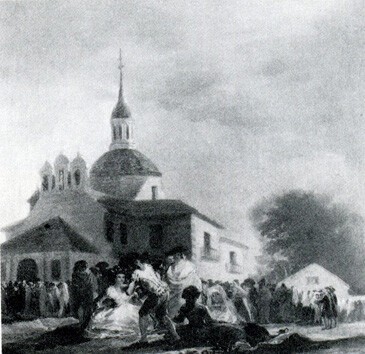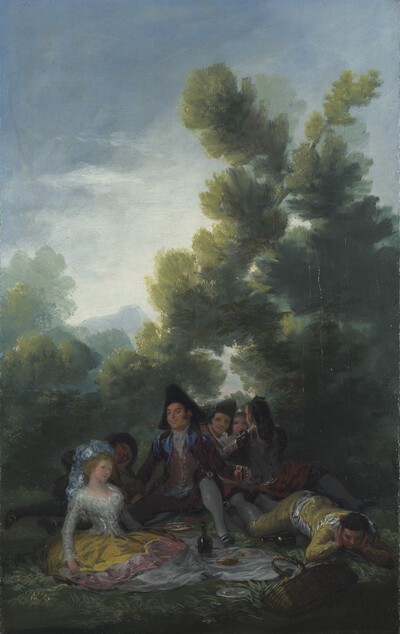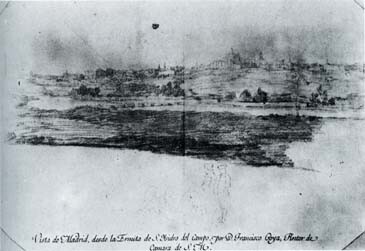- Cronología
- 1788
- Ubicación
- The Prado National Museum. Madrid, Madrid, Spain
- Dimensiones
- 41.8 x 43.8 cm
- Técnica y soporte
- Oil on canvas
- Reconocimiento de la autoría de Goya
- Documented work
- Titular
- El Prado National Museum
- Ficha: realización/revisión
- 17 Dec 2009 / 14 Jun 2023
- Inventario
- (P02783)
The tapestry cartoon for which this sketch was made was never in fact painted. It formed part of the series that would have decorated the bedroom of the Infantas, a commission that Goya received towards the end of 1787 (see Blind Man's Buff).
The sketch was acquired from the artist by the Duke and Duchess of Osuna in 1798 and it remained in the cabinet that the Duchess had in La Alameda until it was sold at the time of the bankruptcy of the ducal household in 1896. It was bought for the sum of 3,500 pesetas by Pedro Fernández Durán, who left it to the Prado Museum in 1930. It entered the museum's collection on 2 September 1931.
The tapestry cartoon that was to have been made from this sketch was never carried out, as occurred with three out of the four sketches in the series meant to adorn the bedroom of the Infantas in the palace of El Pardo. The death of Charles III in December 1788 interrupted the work on the décor of this palace, which the family stopped using soon afterwards.
Because of its subject matter, this work is paired with another sketch for a tapestry cartoon, The Meadow of San Isidro. Both of these paintings represent a very specific place in Madrid at a very particular moment: the festivities in honour of the patron saint of the city, in which people of all classes took part, from majos right through to petimetres, all wanting their share of the miraculous water. According to the legend, the saint had brought forth a spring here and on the very spot a shrine was built in the 16th century, later replaced in the 18th century by the chapel that Goya immortalizes here. It is this building that provides the work's pronounced pyramid-shaped composition.
-
Exposición y venta de los cuadros, esculturas, grabados y otros objetos artísticos de la Casa DucaPalacio de la Industria y de las ArtesMadrid18961896cat. 79
-
De El Greco a GoyaPalacio de Bellas ArtesMexico D.F.1978November-December 1978cat. 33
-
El arte europeo en la corte de España durante el siglo XVIIIGalerie des Beaux-ArtsBurdeos1979Exhibitied also at Grand Palais, París y Museo Nacional del Prado, Madridcat. 20 (16)
-
Madrid pintado. La imagen de Madrid a través de la pinturaMuseo Municipal de MadridMadrid1992cat. 50
-
Goya. El Capricho y la Invención. Cuadros de gabinete, bocetos y miniaturasMuseo Nacional del PradoMadrid1993from November 18th 1993 to February 15th 1994. Exhibited also at the Royal Academy of Arts, London, March 18th to June 12th 1994 and The Art Institute of Chicago, Chicago, July 16th to October 16th 1994, consultant editors Manuela B. Mena Marqués and Juliet Wilson-Bareaucat. 25
-
Goya. 250 AniversarioMuseo Nacional del PradoMadrid1996consultant editor Juan J. Luna. From March 29th to June 2nd 1996cat. 48
-
L'œuvre peint de Goya. 4 volsParís1928-1950vol. I, p. 206, cat. 168
-
Tapices de GoyaMadridPatrimonio Nacional1946pp. 156, 266, cat. 54 y láms. 170-171
-
Vie et ouvre de Francisco de GoyaParísOffice du livre1970pp. 79, 98, cat. 273
-
BarcelonaPolígrafa1970vol. I, p. 275, cat. 253
-
L’opera pittorica completa di GoyaMilanRizzoli1974p. 102, cat. 232
-
Francisco de Goya, cartones y tapicescol. col. "Espasa Arte"Espasa Calpe1987pp. 155, 157, 178, 182, cat. 59B; p. 177
-
Francisco de Goya. Los cartones para tapices y los comienzos de su carrera en la corte de Madridcol. col. "Ensayos de Arte Cátedra"MadridCátedra1987pp. 234, 235 y p. 234 (il.)
-
Goya. El capricho y la invención. Cuadros de gabinete, bocetos y miniaturasMadridMuseo del Prado1993pp. 172, 178, 356, cat. 25 y p. 175 (il.
-
Goya. 250 AniversarioMadridMuseo del Prado1996p. 327, cat. 48 y pp. 128, 129 (ils.)
-
Salas del Palacio Real de El Pardo para las que se tejieron tapices sobre cartones de Francisco de Goya: identificación de las habitaciones y ajuste de las obras de Goya en los alzados de las paredesin HERRERO CARRETERO, Concha (curator, Tapices y cartones de Goya (catalogue of the exhibition organizated at the Palacio Real de Madrid, from may to june 1996)MadridPatrimonio Nacional, Goya 96, Lunwerg1996p. 172 (il.)




